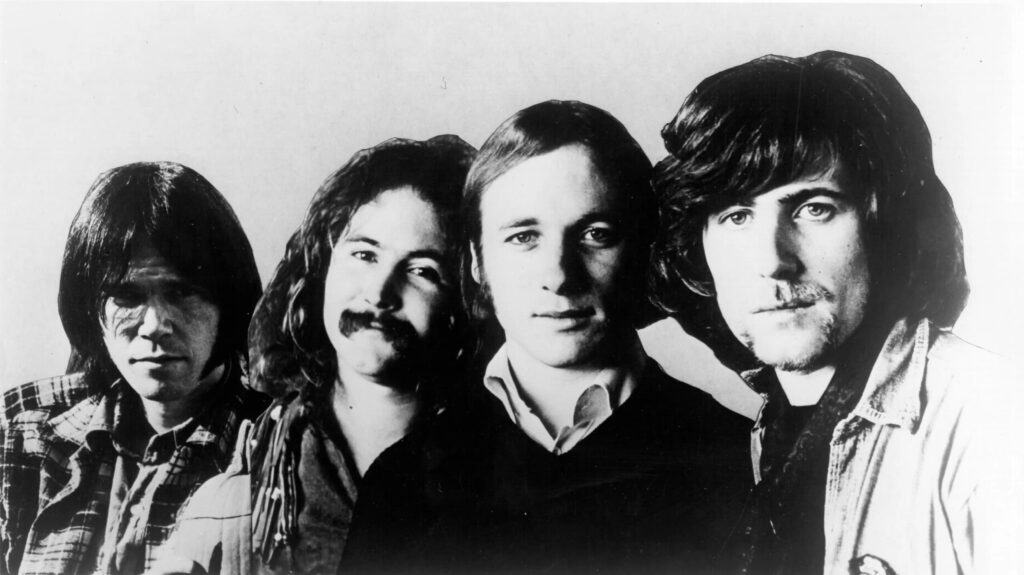
“Carry On”: A Clarion Call for Resilience and Hope Amidst Turmoil
There are songs that capture a fleeting moment, and then there are songs that define an era, resonating with a timeless message that echoes through generations. Crosby, Stills, Nash & Young’s “Carry On” firmly belongs to the latter. This isn’t merely a track; it’s an anthem, a stirring testament to perseverance, unity, and the indomitable spirit of hope in the face of chaos. Released in 1970 on their monumental album Déjà Vu, “Carry On” quickly became a staple of FM radio and a rallying cry for a generation navigating immense social and political upheaval. While it wasn’t officially released as a single in the conventional sense that would typically lead to a singular chart position on the Hot 100, its pervasive presence on album-oriented rock radio made it an instant, indelible classic. The album Déjà Vu itself was a massive commercial success, topping the Billboard 200 album chart, and “Carry On” was undeniably one of its cornerstones, cementing the supergroup’s legendary status.
To truly understand “Carry On,” one must recall the tumultuous backdrop against which it emerged. The year 1970 was a cauldron of change: the Vietnam War raged on, the Kent State shootings had just shaken the nation, and the idealism of the 1960s was giving way to a more fractured, uncertain future. It was a time when many felt adrift, seeking solace and direction. It was in this crucible that Stephen Stills, the primary architect of “Carry On,” found his inspiration. The song is famously a medley of two distinct song fragments: one, an unreleased Buffalo Springfield song by Stills titled “Questions,” and the other, a newer composition. Stills meticulously wove these pieces together, showcasing his remarkable songwriting and arranging prowess. The genesis of the song speaks to the collaborative yet often volatile dynamic within the supergroup; it was a testament to their individual brilliance coalescing into something greater than the sum of its parts, even if those parts sometimes clashed.
The profound meaning of “Carry On” lies in its dual message: an acknowledgment of struggle and an urgent plea for continued perseverance. The opening lines immediately set a reflective tone, acknowledging the “road is long” and the weariness that can set in. Yet, the chorus bursts forth with an unwavering optimism, a direct exhortation to “carry on” despite the burdens. It’s a call to keep moving forward, to find strength in unity (“we are one”), and to hold onto hope (“the fire’s still burning”). For an older generation, it resonates with the wisdom gained from navigating life’s many storms – the career setbacks, the personal losses, the societal shifts. It’s a reminder that resilience is not about ignoring pain, but moving through it, often finding companionship and renewed purpose along the way. The lyrics speak to a universal human experience of facing adversity and finding the courage to persist, even when the path ahead is unclear.
The sonic landscape of “Carry On” is as rich and intricate as its lyrical depth. Stephen Stills’ masterful guitar work, from the iconic acoustic intro to the searing electric solos, drives the song with an almost primal energy. The layered vocal harmonies of Crosby, Stills, Nash & Young are, as always, a signature element, soaring and blending with an ethereal quality that elevates the track from a simple folk-rock tune to an almost spiritual experience. Each voice, unique in its timbre, contributes to a collective sound that feels both powerful and comforting. The dynamism within the song, shifting from moments of introspective acoustic beauty to bursts of electrifying rock, perfectly mirrors the emotional journey it describes – from quiet contemplation of difficulty to the explosive resolve to forge ahead.
“Carry On” has endured not just as a classic rock staple, but as a cultural touchstone. It’s a song that can still evoke a collective sigh of recognition, a knowing nod from those who remember the weight of the era it emerged from, and a hopeful spark for those who discover its message today. It serves as a potent reminder that even when the world feels fragmented and uncertain, there is an inherent strength in carrying on, in finding kinship, and in believing that the “road is long, but it bends.” For many of us, it’s a treasured memory of an era defined by music that dared to speak truth and inspire resilience, leaving us with the enduring belief that even after the darkest nights, the dawn will “carry on.”